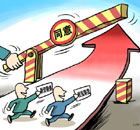Top Biz News
Bank reserve ratio raised to curb lending
By Zhang Ran (China Daily)
Updated: 2010-01-13 07:52
 |
Large Medium Small |
The central bank yesterday raised the reserve requirement ratio - the proportion of deposits that banks must hold in reserve - in a clear sign that it was determined to drain excessive liquidity in the market and curb lending.
The 0.5 percentage point increase is effective Jan 18, the People's Bank of China (PBOC) said. It was the first time that the central bank raised the ratio since June 2008.
The move is meant to stabilize loan growth but keep overall policy pro-growth, Reuters quoted a central bank official as saying.
"Our monetary policy stance is still appropriately loose and the move is intended to use quantitative tools for flexible fine-tuning," the official said.
The PBOC also drained 200 billion yuan ($29.3 billion) from the money market yesterday through 28-day bond repurchase agreements.
It was the central bank's largest mop-up via a repo of that maturity since 2003, when it started regular open market operations. This is in addition to mopping up 20 billion yuan via the sale of one-year bills yesterday.
Last week, the central bank mopped up 137 billion yuan from the market, the biggest weekly net drain since late October.
"The hike in the reserve requirement ratio and increasing open market operations by the central bank indicate the government is strengthening inflation management," said Dong Xian'an, chief economist with Industrial Securities.
"Inflation is the core factor for the central bank to decide whether to tighten monetary policy," said Dong, who raised his consumer price index (CPI) forecast for 2010 to at least a rise of 3.5 percent from the original 3 percent.
| ||||
"The deposit reserve hike is directly aimed at controlling bank lending, and it sends a very clear message to banks that the central bank is not happy about the lending spree," said Yi Xianrong, economist with the Chinese Academy of Social Sciences.
Commercial banks have lent nearly 600 billion yuan in the first week of 2010, the Economic Information Daily reported on Monday.
The surge in loans, nearly twice as much as the monthly average in the last half of 2009, also prompted the central bank to step up credit controls.
Chinese banks traditionally rush to book loans in January to boost their full-year interest earnings, and part of the haste now probably also stems from fears that officials will soon slam the door on lending.
"Bank loans have increased far too rapidly this year compared with late last year," said Li Jianfeng, economist with Shanghai Securities. "This has prompted the central bank to increase the reserve requirement ratio."
Earlier, a rise in the ratio was widely anticipated in the first quarter, with an interest rate increase tipped in the late second quarter or the third quarter.
"We expect the government to warn banks against excessive lending in the first quarter, and we estimate monthly new loans to be about 1 trillion yuan during the first quarter," said Wang Tao, head of UBS China Economic Research.
"As for the use of specific policy instruments, the most likely near-term policy change is for the PBOC to raise the reserve requirement ratio." Jun Ma, chief economist with Deutsche Bank China said.
During the first 11 months of last year, new loans reached 9.21 trillion yuan. Analysts expect the country's banks to lend around 7.5 trillion yuan this year, down from a record 9.5 trillion yuan in 2009.
Reuters contributed to the story













